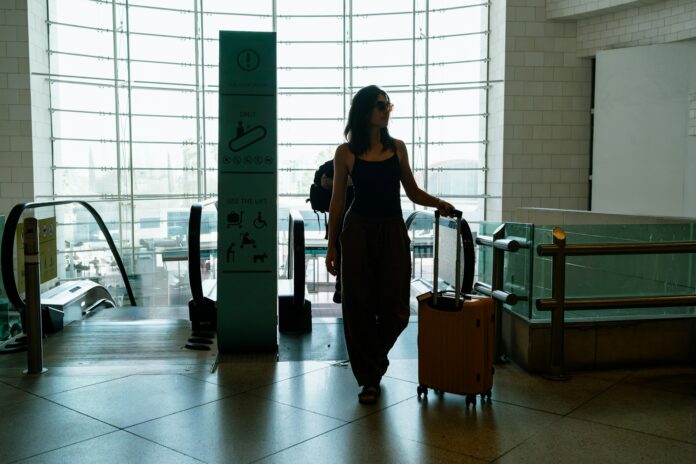We’ve all been there – staring at our limited annual leave days, trying to figure out how to see more of the world without quitting our jobs. With rising flight costs and growing environmental concerns about frequent long-haul travel, the question becomes: how can we experience more while flying less?
Multi-country trips provide an elegant solution. Instead of making separate journeys throughout the year, you can experience dramatically different cultures, landscapes, and cuisines in one go, while only taking a single long-haul flight. Llama Travel, who offer a selection of combination tours, tell us that these types of holidays are growing in popularity. Perhaps driven by the fact that it means you get to tick more off your bucket list in one trip.
However, the real value of these trips isn’t about country-counting. It’s about understanding regions as interconnected wholes rather than isolated destinations. Border areas often reveal fascinating cultural blending that you’d miss by visiting countries separately. You’ll notice how languages shift gradually, how cooking techniques borrow from neighbours but maintain distinct identities, and how shared histories have led to divergent presents.
Here are five multi-country combinations that work particularly well within a standard two-week holiday. Each has been selected not only for geographical proximity but for the way the destinations complement and contrast with each other, creating a more textured travel experience than you’d get from visiting any single country.
Vietnam, Cambodia & Laos
Southeast Asia offers a fascinating blend of ancient traditions, stunning landscapes, and vibrant cities. These three neighbouring countries provide a perfect combination of cultural immersion, historical exploration, and natural beauty. Vietnam captivates with its dramatic landscapes, from the terraced rice fields of Sapa to the limestone karsts of Halong Bay. Cambodia boasts the magnificent Angkor temple complex, a testament to the once-mighty Khmer Empire. Meanwhile, Laos charms visitors with its laid-back atmosphere and unspoilt natural scenery along the Mekong River.
This trip packs a remarkable variety into a compact geographical area. In Vietnam, the frenetic pace of Hanoi and Ho Chi Minh City contrasts with the rural calm of Sapa’s agricultural communities. Cambodia’s Angkor Wat remains one of humanity’s most impressive architectural achievements, while Laos offers moments of tranquility along the Mekong that have largely disappeared elsewhere in Southeast Asia.
What makes this combination work is the gradual shift in pace and development. Vietnam’s rapid economic growth and urban energy give way to Cambodia’s rebuilding society, followed by Laos’ more traditional pace of life. The transition feels natural, giving travellers time to decompress between bustling cities and quiet river towns.
Historically, these countries share deep connections through centuries of complex relationships with China, France, and each other. Their religious practices blend similar elements but retain distinct expressions – from Vietnam’s incense-filled pagodas to Cambodia’s grand temples to Laos’ dawn alms-giving ceremonies. The food similarly shares a foundation of rice, fresh herbs, and fish sauce, but diverges in fascinating ways that reflect each country’s resources and influences.
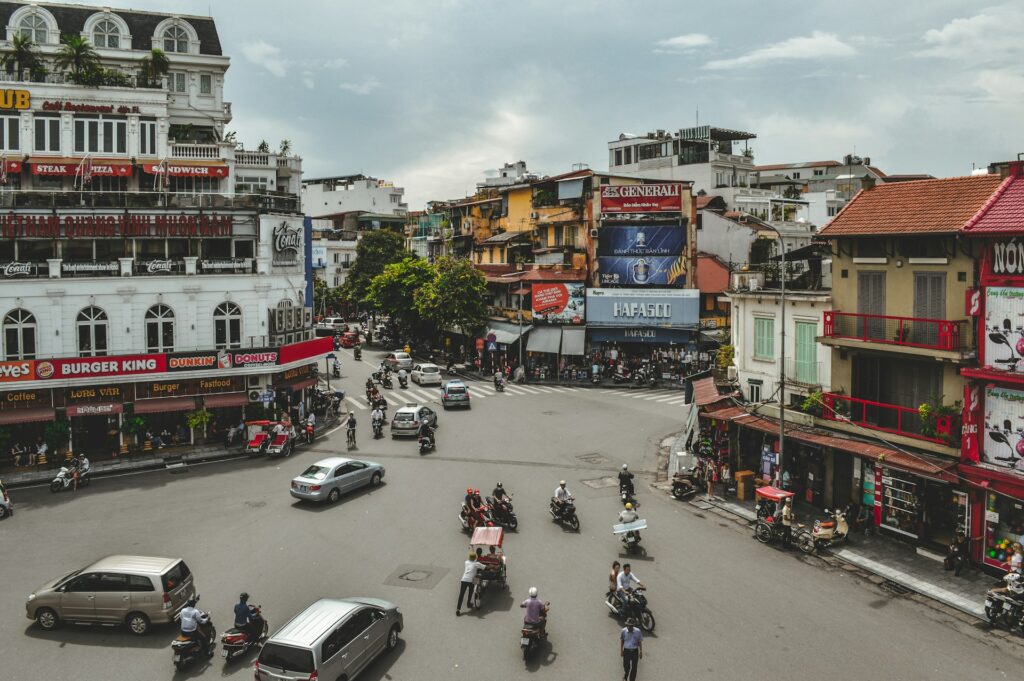
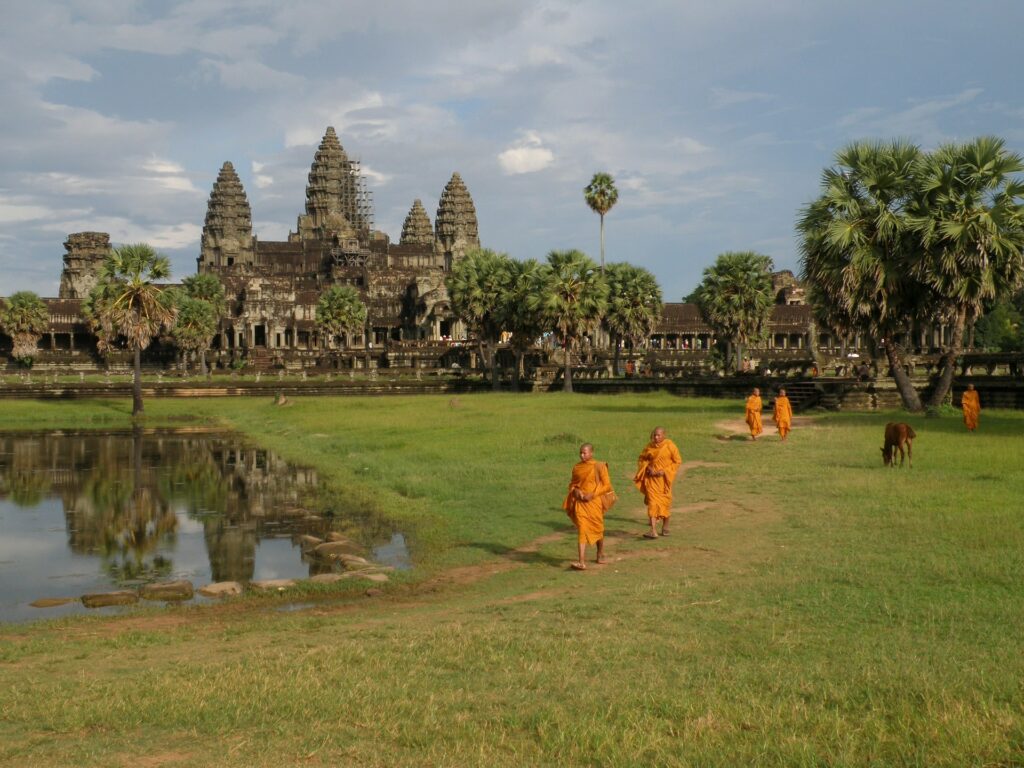
Ideal For: This itinerary makes sense for first-time visitors to Asia who want diversity without the logistical challenges of covering too much ground. Food enthusiasts will appreciate how fundamental ingredients transform across borders – for instance, how fish sauce appears as nước mắm in Vietnam’s zesty dipping sauces, takes on a sweeter profile as tuk trey in Cambodia’s curry dishes, and becomes a more subtle background note in Laos’ jeow bong chilli paste.
Photographers find endless subjects, from the early morning mist rising over Angkor Wat’s spires to Halong Bay’s emerald waters dotted with limestone karsts, and Luang Prabang’s saffron-robed monks collecting alms at dawn. History enthusiasts will appreciate seeing how the region’s complex past manifests differently in each country – from Vietnam’s War Remnants Museum in Ho Chi Minh City documenting the American War, to Cambodia’s sobering Killing Fields memorial outside Phnom Penh, to Laos’ UXO Centre in Luang Prabang revealing the devastating impact of unexploded ordnance from the Secret War.
Those with moderate budgets can travel comfortably here – a mid-range hotel room in Hoi An, Vietnam (around £40-70 per night) offers considerably more luxury than the equivalent price point in Western destinations, while meals at excellent local restaurants often cost under £10 per person.
Practical Considerations:
- Best time to visit: November to April (dry season)
- Visa requirements: Most visitors need visas for all three countries; e-visas are available
- Flight hub: Bangkok serves as an excellent gateway with frequent connections to all three countries
- Currency: Vietnamese Dong (VND), Cambodian Riel (KHR), Lao Kip (LAK) — US dollars widely accepted in Cambodia
- Border crossings: Land borders exist between all countries, but flights save considerable time
- Transportation between countries: 1-2 hour flights connect major cities; overnight buses available but time-consuming
Peru & The Galapagos Islands
One of the world’s most spectacular multi-country trips, this South American adventure combines the archaeological wonders of Peru with the unparalleled wildlife experience of Ecuador’s Galapagos Islands. From ancient Inca ruins to unique species that inspired Darwin’s theory of evolution, this holiday offers a perfect blend of cultural and natural marvels.
Indeed, Peru offers remarkable archaeological treasures, from Machu Picchu perched in the clouds to the mysterious Nazca Lines etched into desert plains. The Galapagos Islands present a living laboratory of evolution where animals show no fear of humans and marine life flourishes in protected waters.
What makes this double destination work is the profound contrast between human achievement and natural evolution. Peru showcases the heights of pre-Columbian civilisation – the engineering precision of Inca stonework, the sophisticated agricultural terracing, and the organisational complexity needed to build an empire without wheeled vehicles or written language. The Galapagos, meanwhile, reveals how life adapts and diversifies in isolation, the very process that inspired Darwin’s theory of evolution.
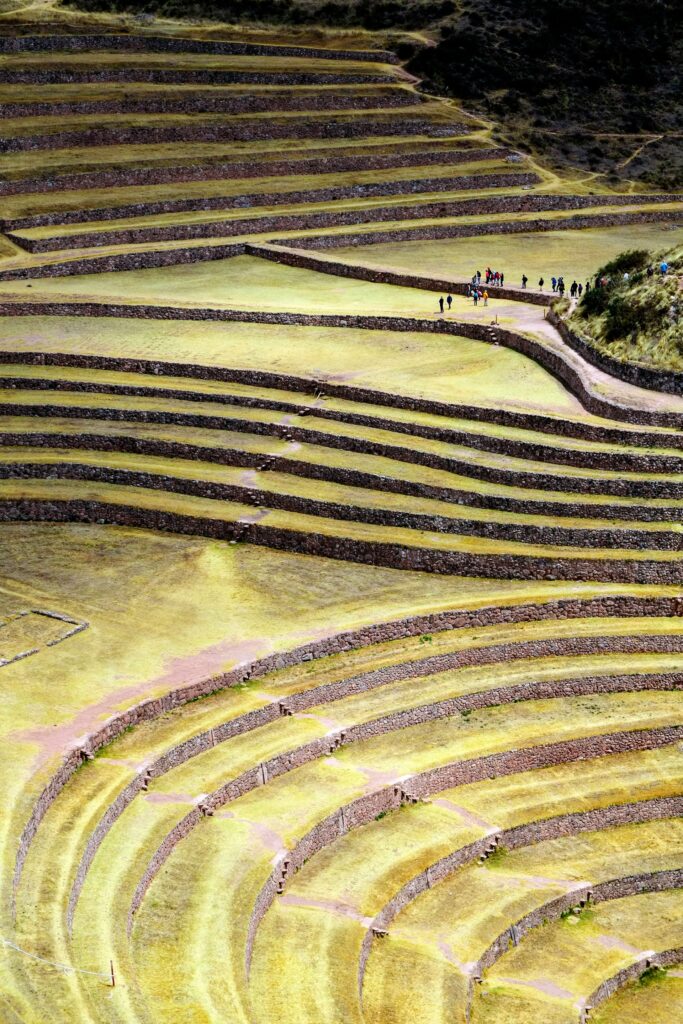
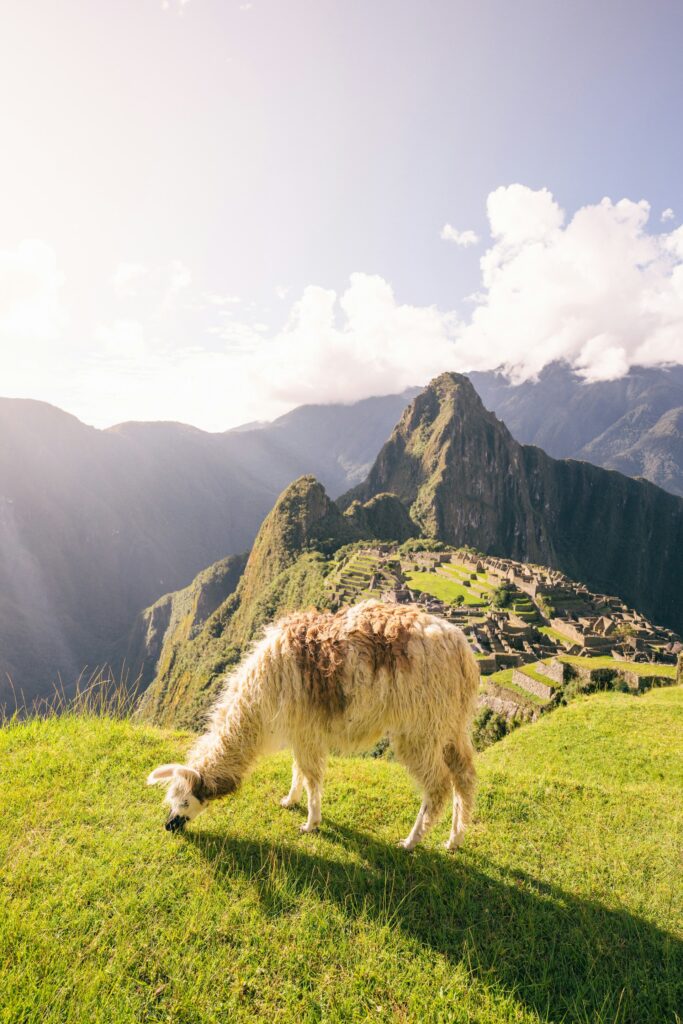
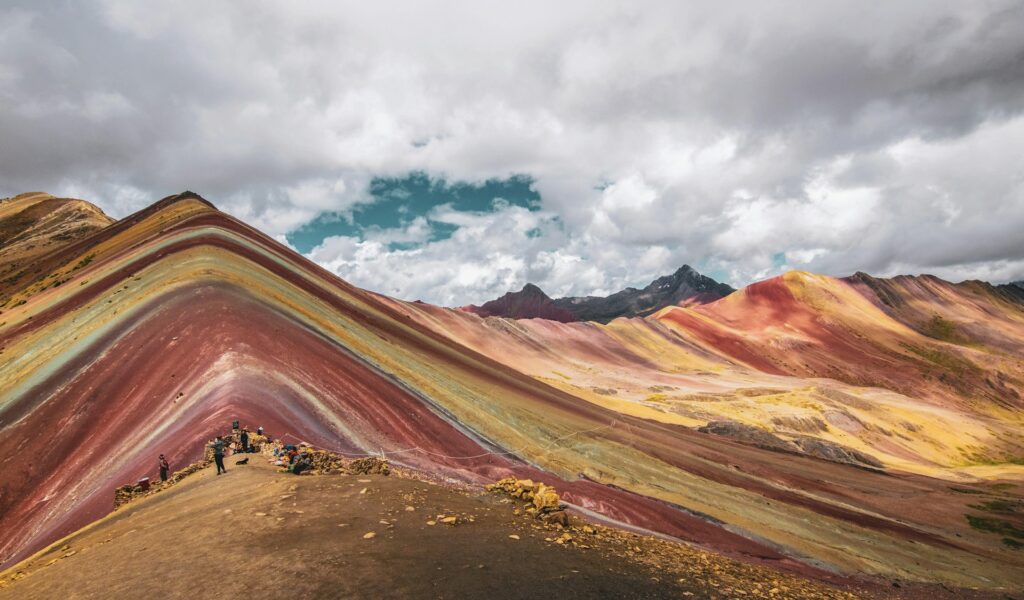
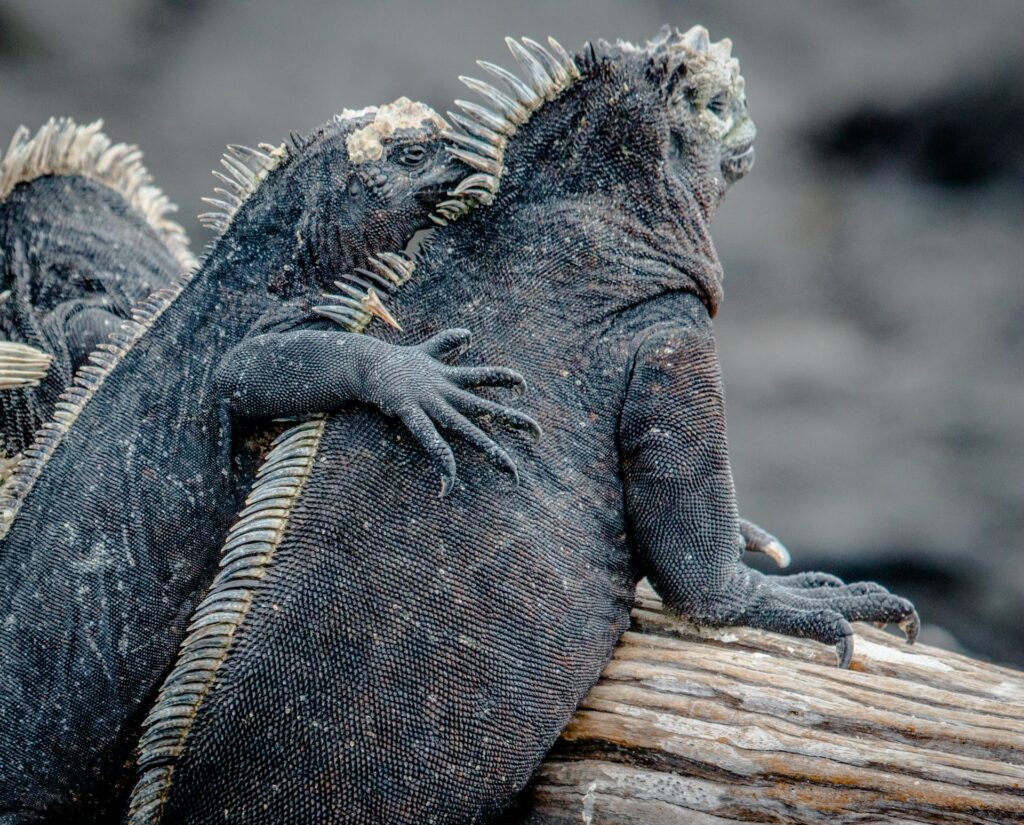

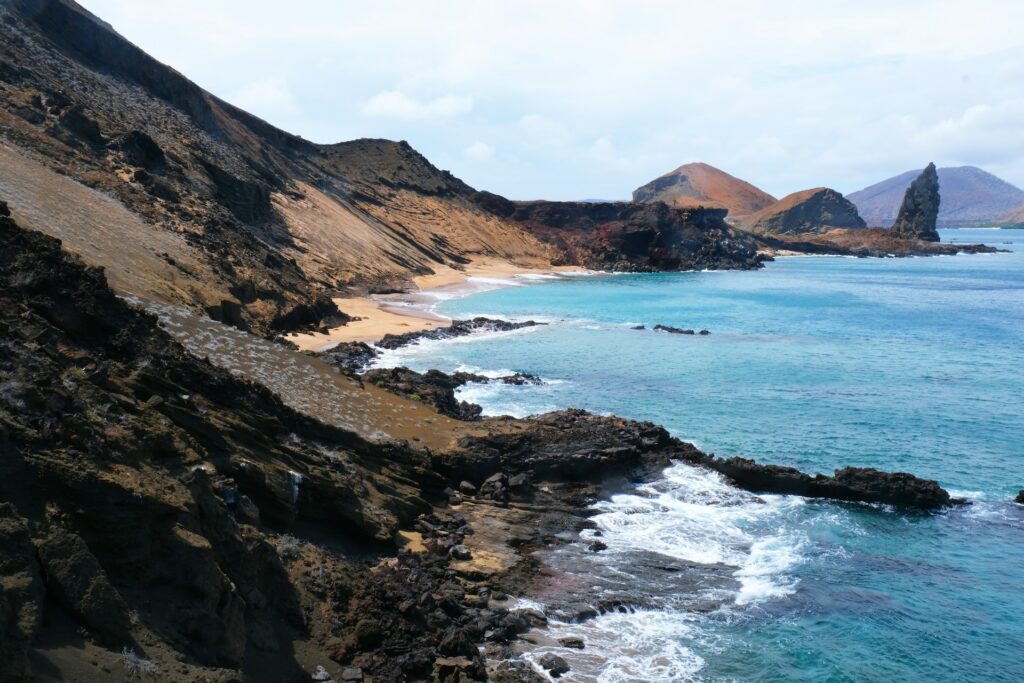
Moreover, the geographical diversity within this journey is remarkable. Peru’s vertical geography creates multiple ecosystems stacked upon each other – from coastal desert to Andean highlands to cloud forest – all within relatively short distances. The Galapagos adds a volcanic island environment where isolation has created unique adaptations among species found nowhere else on Earth. Together, they offer a comprehensive picture of South America’s extraordinary natural and cultural heritage.
Ideal For: This journey appeals to travellers interested in both history and natural science. Wildlife photographers find unparalleled opportunities in the Galapagos, where animals allow close approaches – imagine capturing frame-filling shots of marine iguanas basking on black volcanic rocks, blue-footed boobies performing their distinctive mating dance just meters away, or swimming eye-to-eye with playful sea lion pups who approach with genuine curiosity.
Hikers enjoy both the Inca Trail and the volcanic paths of the islands – the classic 4-day Inca Trail trek rewards with diverse ecosystems from cloud forest to alpine tundra, while Bartolomé Island in the Galapagos offers a shorter but equally memorable hike across otherworldly lava formations to a summit with panoramic views of Pinnacle Rock. Those intrigued by indigenous cultures can explore living traditions in Peru’s Sacred Valley communities, where weavers in Chinchero still create textiles using techniques and natural dyes passed down through generations, or visit Ollantaytambo’s village, where many residents live in Inca-built stone houses with original irrigation channels still flowing through the streets.
Active travellers appreciate the variety – from mountain trekking to snorkeling with sea lions, hammerhead sharks, and tropical fish in the nutrient-rich waters where cold Humboldt currents meet warm tropical waters. This combination also works well for those who enjoy structured tours, as both destinations benefit from expert guidance – a knowledgeable guide can transform Machu Picchu from impressive ruins to a vivid historical narrative, while Galapagos naturalists help spot and identify the subtle differences between species across different islands that showcase evolution in action.
Practical Considerations:
- Best time to visit: May to October (dry season in Peru); December to May (warmer, wetter season) is best for Galapagos wildlife
- Visa requirements: Most Western visitors receive free entry permits for both Peru and Ecuador
- Flight connections: Lima is the main hub for Peru; flights to Ecuador usually connect through Quito or Guayaquil
- Altitude considerations: Cusco sits at 3,400m above sea level; acclimatisation is essential
- Galapagos entry requirements: Special Galapagos Transit Card and National Park entry fee required
- Currency: Peruvian Sol (PEN); US Dollars (USD) used in Ecuador and Galapagos
- Island transportation: Inter-island travel in Galapagos requires either pre-booked cruises or speedboat services
Read: Is Cusco, Peru, Worth Visiting?
Botswana, South Africa & Victoria Falls
Africa offers an unparalleled safari experience combined with magnificent natural wonders. This itinerary takes you through some of southern Africa’s most spectacular landscapes and wildlife areas, from the pristine waterways of the Okavango Delta to the thundering Victoria Falls.
Botswana is renowned for its conservation efforts and offers some of Africa’s best game viewing. South Africa combines sophisticated cities with excellent wildlife opportunities. Zimbabwe and Zambia share the magnificent Victoria Falls, known locally as ‘The Smoke That Thunders’, creating a perfect triumvirate for an unforgettable African adventure.
The brilliance of this combination lies in its natural progression. Starting in South Africa eases you into the African experience with familiar urban comforts before transitioning to Botswana’s more remote wilderness. The journey culminates at Victoria Falls, where the natural spectacle provides a perfect reflective bookend to the trip.
The wildlife viewing experiences complement rather than repeat each other. South Africa’s savanna ecosystems host classic big game encounters, while Botswana’s watery Okavango Delta reveals how animals adapt to seasonal flooding. The different conservation models – from South Africa’s fenced reserves to Botswana’s vast unfenced wilderness – also provide insight into the complexities of wildlife protection.
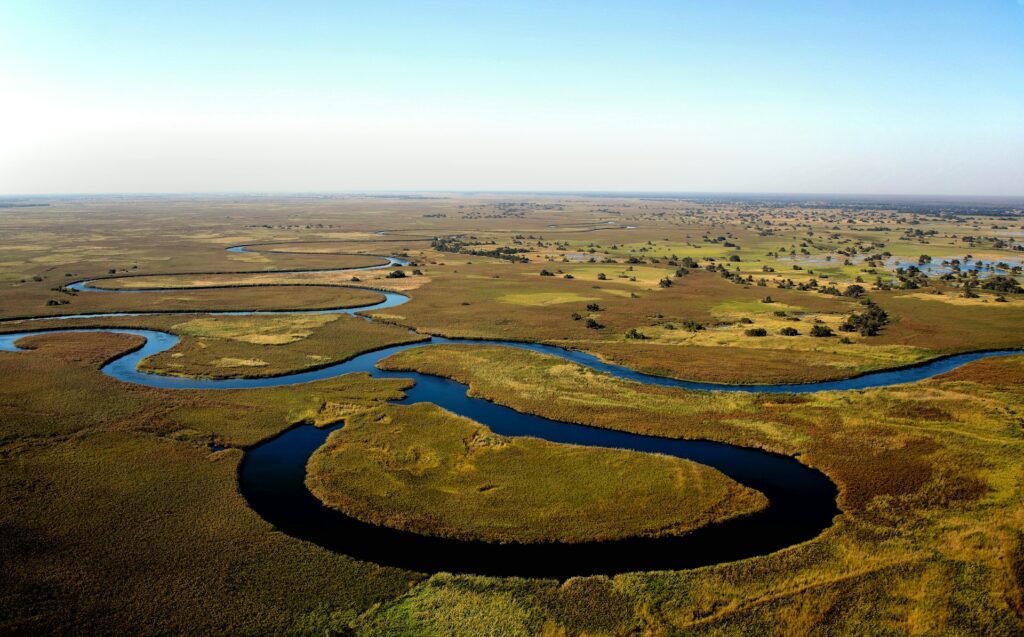
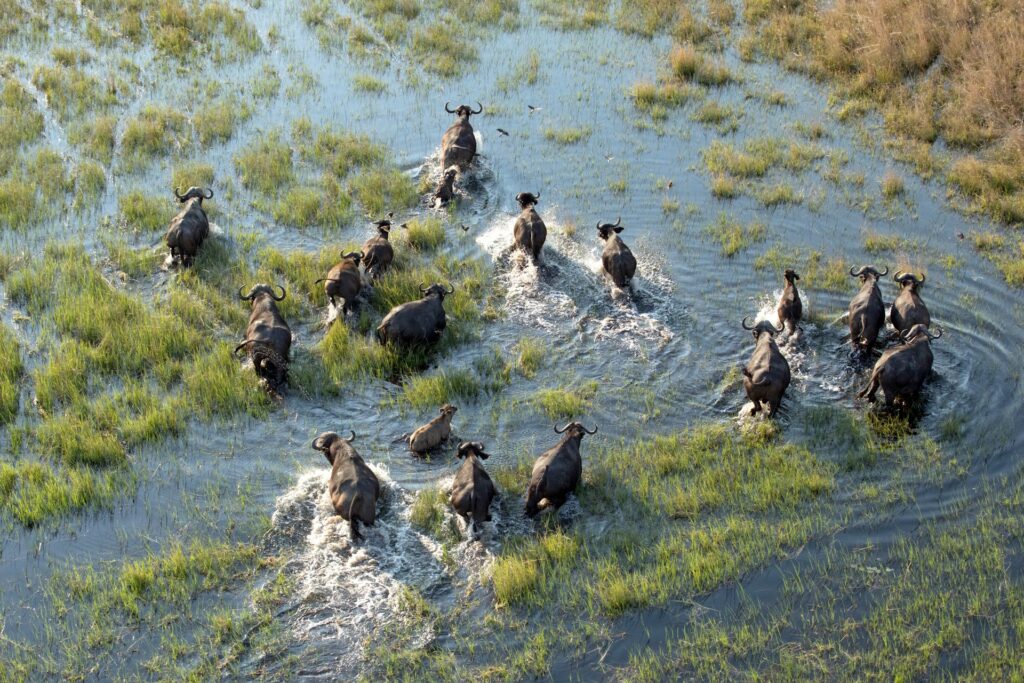
Ideal For: This itinerary suits wildlife photographers who need varied subjects and settings – South Africa’s Kruger National Park offers reliable sightings of the “Big Five” (lion, leopard, elephant, buffalo, and rhino) against dramatic savanna backdrops, while Botswana’s Okavango Delta provides unique opportunities to photograph elephants wading through crystal-clear channels or red lechwe antelope leaping through shallow floodplains. At Victoria Falls, photographers can capture rainbows arcing through the mist during morning golden hour from viewpoints along the Knife-Edge Bridge.
It works well for first-time safari-goers who want comprehensive wildlife experiences without the logistical challenges of East African travel – South Africa’s excellent road infrastructure and self-drive options in Kruger National Park allow for an accessible introduction to safari, while Botswana’s high-end lodges provide a more exclusive experience with expert guides. The combination accommodates both high-end travellers, who can enjoy world-class lodges in Botswana’s private concessions like Mombo Camp in the Okavango Delta (where nightly rates include gourmet meals, premium beverages, and twice-daily game drives), and mid-range budgets, which might focus more time in South Africa at places like Sabi Sands Game Reserve, where excellent lodges start around, £390 per night.
Active travellers will appreciate the range of activities at Victoria Falls, from white-water rafting through the Batoka Gorge’s grade 5 rapids to bungee jumping from the 111-meter Victoria Falls Bridge, helicopter “Flight of Angels” tours providing aerial views of the falls, or more serene sunset cruises on the Zambezi River where hippos and crocodiles can be spotted from the safety of the boat.
Practical Information:
- Best time to visit: May to October (dry winter season) for best wildlife viewing; Victoria Falls is most spectacular March-May after rainy season
- Visa requirements: Most Western visitors receive visa-free entry or visa-on-arrival for South Africa; visas required for Botswana, Zimbabwe, and Zambia (KAZA Uni-Visa covers both Zimbabwe and Zambia)
- Flight connections: Johannesburg serves as the main regional hub with connections to all destinations
- Border crossings: Victoria Falls town (Zimbabwe) to Livingstone (Zambia) is a simple border crossing via Victoria Falls Bridge
- Safari considerations: Book well in advance (6-12 months) for premium Botswana lodges; high-end accommodations often include internal flights
- Currency: South African Rand (ZAR), Botswana Pula (BWP), US Dollars widely accepted at Victoria Falls
- Health requirements: Yellow fever certificate may be required; malaria prophylaxis recommended
Argentina, Chile & Brazil
South America’s southern cone offers dramatic landscapes, vibrant cities, and cultural richness. This journey takes you from the passionate tango halls of Buenos Aires to the breathtaking wilderness of Patagonia and the pulsating energy of Rio de Janeiro.
Argentina seduces with European-influenced sophistication and magnificent natural wonders like Iguazu Falls. Chile impresses with the dramatic scenery of Torres del Paine National Park. Brazil captivates with its exuberant culture and the iconic cityscape of Rio de Janeiro, making this combination an unforgettable South American experience.
These countries work well together because they represent such different aspects of South American identity. Argentina’s European heritage and pastoral traditions meet Chile’s more indigenous-influenced culture and maritime focus. Brazil adds Afro-Caribbean influences and tropical rhythms absent in its more temperate neighbors. Together, they showcase the continent’s full spectrum of cultural influences.
The geographic contrast is equally compelling. Moving from Argentina’s endless pampas to the soaring Andes shared with Chile, then to Brazil’s coastal ranges and beaches, creates a journey through increasingly dramatic landscapes. Patagonia, experienced from both Argentinian and Chilean perspectives, reveals how the same remarkable environment has been incorporated differently into each country’s national identity.
Read: 5 Ideal Dishes To Try In Brazil
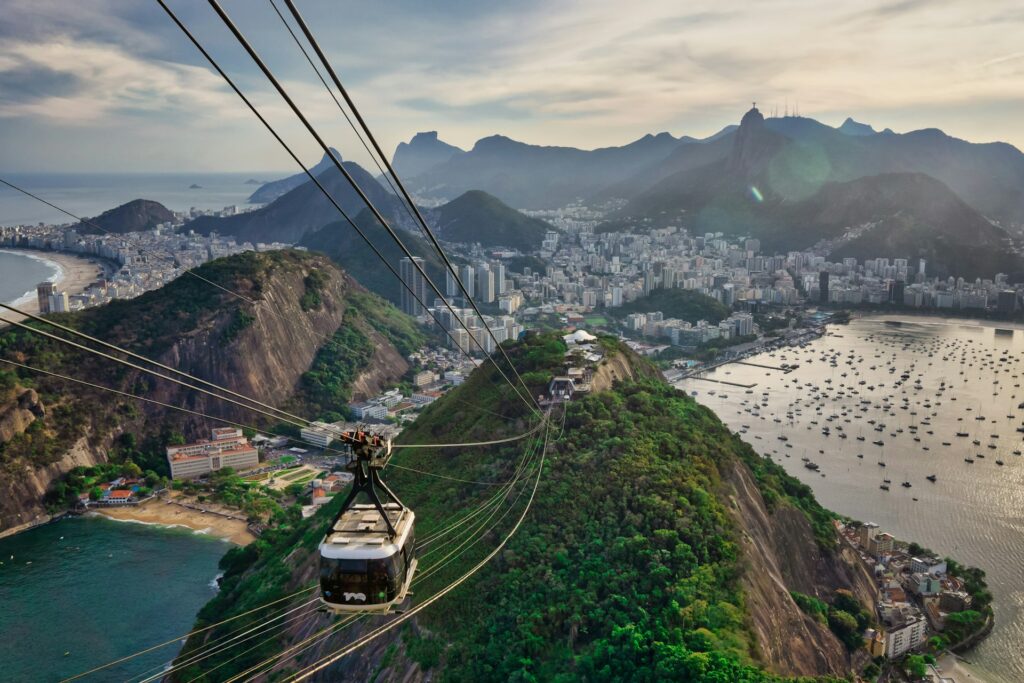
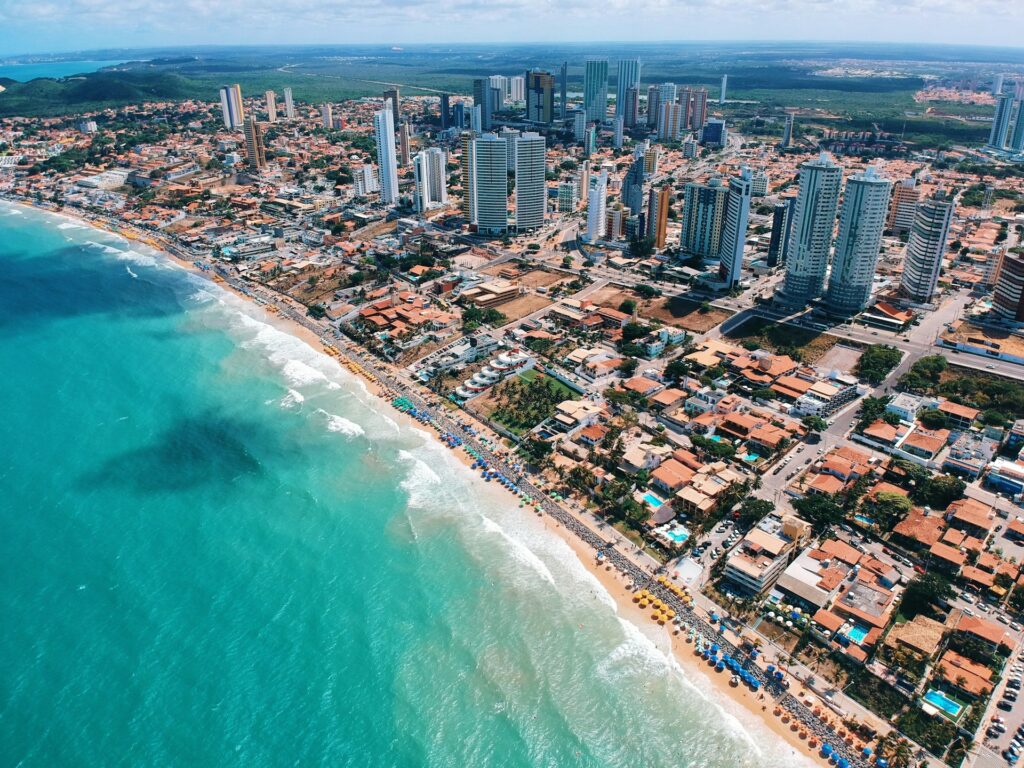
Ideal for: Wine enthusiasts will love exploring both Argentine and Chilean vineyards with their distinctive approaches – Argentina’s high-altitude Mendoza region produces bold, fruit-forward Malbecs that thrive in the hot, dry climate at the foothills of the Andes, while Chile’s cooler Casablanca Valley, influenced by Pacific Ocean breezes, creates elegant Sauvignon Blancs and Pinot Noirs with bright acidity. Many wineries offer comprehensive tours with expert-led tastings, like Catena Zapata’s dramatic Mayan-inspired facility in Mendoza or Casas del Bosque’s scenic estate in Chile, where visitors can sample reserve wines unavailable for export.
Dance lovers can move from Argentina’s structured tango at historic venues like Salon Canning in Buenos Aires, where locals dance until dawn, to Brazil’s free-flowing samba at Rio’s Pedra do Sal, the birthplace of samba where Monday night street parties attract both tourists and cariocas (Rio locals). Outdoor enthusiasts will find world-class hiking in Patagonia, such as the famous W Trek in Chile’s Torres del Paine National Park, with its iconic granite spires, azure lakes, and hanging glaciers, or Argentina’s Los Glaciares National Park, home to the advancing Perito Moreno Glacier where visitors can witness massive ice chunks calving into Lago Argentino.
City lovers can explore three dramatically different urban expressions – Buenos Aires’ elegant European-inspired boulevards and neighborhoods like Recoleta with its famous cemetery containing elaborate mausoleums, Santiago’s modern financial district crowned by Sky Costanera (Latin America’s tallest building) alongside colonial plazas, and Rio’s dramatic setting between mountains and sea, best appreciated from the Christ the Redeemer statue atop Corcovado Mountain. Those interested in understanding South America’s complex identity will appreciate how these three countries represent different facets of the continent’s heritage – from Argentina’s gaucho culture celebrated at traditional estancias (ranches), to Chile’s indigenous Mapuche influences evident in local cuisine and crafts, to Brazil’s Afro-Brazilian traditions showcased in Salvador da Bahia’s colorful Pelourinho district.
Read: The Best Steakhouses & Parrillas In Buenos Aires, Argentina
Practical Considerations:
- Best time to visit: October to April (Southern Hemisphere spring/summer) for Patagonia; year-round for Buenos Aires and Rio
- Visa requirements: Most Western visitors enter Argentina and Chile visa-free; Brazil requires visas for some nationalities (including USA)
- Flight connections: Buenos Aires is the main regional hub; internal flights essential due to vast distances
- Border crossing: Chile-Argentina Patagonian border is straightforward but can be weather-dependent
- Language considerations: Spanish in Argentina and Chile; Portuguese in Brazil
- Currency: Argentine Peso (ARS), Chilean Peso (CLP), Brazilian Real (BRL) — ATMs widely available in cities
- Internal flights: LATAM and Aerolíneas Argentinas connect most destinations; book domestic flights 2-3 months in advance
Costa Rica, Guatemala & Panama
Central America packs extraordinary biodiversity, ancient Maya ruins, and pristine beaches into a relatively small area. This itinerary combines three distinct countries offering rainforests, colonial cities, indigenous cultures, and engineering marvels.
Costa Rica’s conservation-focused development has preserved remarkable wildlife habitat alongside comfortable tourism infrastructure. Guatemala offers the region’s richest indigenous culture and most impressive Mayan sites. Panama’s canal zone represents a fascinating meeting point of global commerce, engineering achievement, and ecological transition between North and South America.
This combination creates a perfect historical arc: Guatemala’s ancient Maya civilization and colonial period, Costa Rica’s modern environmental leadership, and Panama’s position at the crossroads of global trade. The three countries together tell a more complete story of Central America than any could individually.
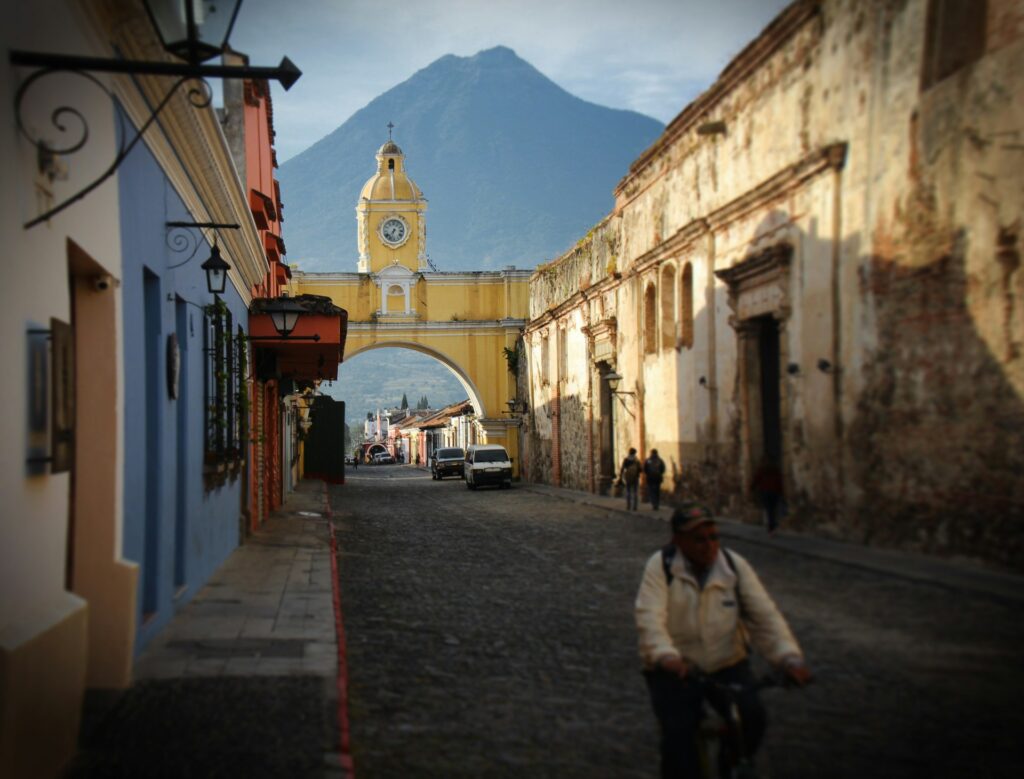
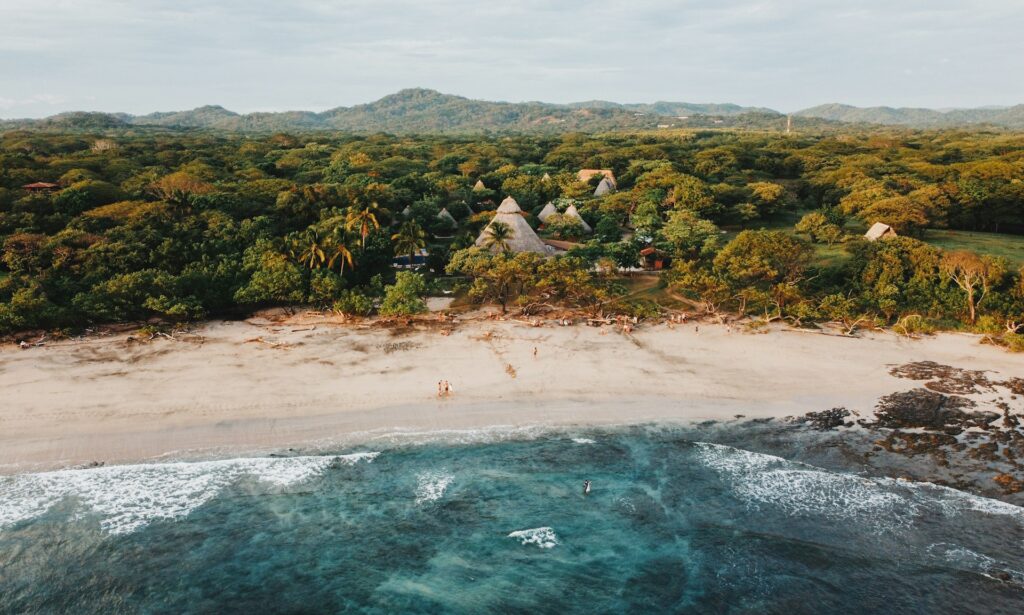
The ecological diversity is equally impressive. Costa Rica’s rainforests and volcanic ecosystems differ significantly from Guatemala’s highland forests and Panama’s unique canal zone environment. Wildlife enthusiasts can observe species adapted to different elevations, rainfall patterns, and geological conditions, all within relatively short travel distances.
Ideal for: This combination satisfies nature enthusiasts who want to identify diverse flora and fauna – in Costa Rica’s Monteverde Cloud Forest, visitors can spot the resplendent quetzal with its iridescent plumage and foot-long tail feathers, while Guatemala’s Lake Atitlán region hosts highland species like the pink-headed warbler found nowhere else, and Panama’s Pipeline Road in Soberanía National Park holds the world record for most bird species counted in a single day (357 species). Each ecosystem reveals different adaptations – from the sloths and howler monkeys of Costa Rica’s lowland rainforests to the scarlet macaws that fly between the Pacific and Caribbean coasts in Panama.
It rewards history buffs interested in Mayan archaeology and colonial architecture – Guatemala’s Tikal National Park features towering 70-meter pyramids emerging from the jungle canopy where visitors can climb Temple IV for views matching the famous scene from Star Wars, while the cobblestone streets of Antigua Guatemala showcase perfectly preserved Spanish colonial buildings framed by three volcanoes. Meanwhile, Panama City offers the unique juxtaposition of the colorful colonial Casco Viejo district alongside the engineering marvel of the Panama Canal’s Miraflores Locks, where visitors can watch massive container ships being raised and lowered as they journey between oceans.
Adventure seekers can choose from numerous activities, from zip-lining through Costa Rica’s Arenal Volcano region, where cables extend up to 750 meters in length over the rainforest canopy, to kayaking among the mangrove forests of Panama’s Bocas del Toro archipelago, or hiking Guatemala’s active Pacaya Volcano where visitors can roast marshmallows over hot vents while watching small eruptions. Families find plenty of child-friendly accommodation and activities, especially in Costa Rica – the Diamante Eco Adventure Park near Liberia offers supervised animal encounters, cultural displays, and Costa Rica’s longest ocean-view zipline appropriate for children as young as four.
Those interested in sustainable travel practices will appreciate seeing Costa Rica’s environmental leadership firsthand – places like Lapa Rios Lodge on the Osa Peninsula demonstrate how luxury tourism can coexist with conservation, operating completely on renewable energy while protecting 1,000 acres of primary rainforest that serves as a wildlife corridor for endangered species like jaguars and scarlet macaws.
Practical Considerations:
- Best time to visit: December to April (dry season) for most regions; shoulder seasons (May, November) offer good value
- Visa requirements: Most Western visitors receive free entry permits for all three countries
- Flight connections: Panama City serves as the main regional hub with connections to both Guatemala City and San José
- Border considerations: Land crossings possible but time-consuming; flights strongly recommended for this itinerary
- Health precautions: Check vaccination requirements; some rural areas have malaria/dengue risk
- Currency: Costa Rican Colón (CRC), Guatemalan Quetzal (GTQ), US Dollar (USD) used in Panama
- Safety notes: Exercise caution in Guatemala City; stick to tourist areas and use registered taxis
The Bottom Line
Multi-country journeys like these offer a richer understanding of regions than single-country visits can provide. The contrasts between neighbouring nations highlight what makes each place distinct, while the connections reveal shared histories and influences. These journeys maximise the value of your limited vacation time without creating the exhaustion of constant movement.
For travellers seeking to understand regions deeply rather than just collecting experiences, these combinations offer a more complete picture than isolated visits ever could. Whether you’re interested in wildlife, ancient civilisations, food, music, or landscapes, these carefully selected two-week itineraries provide remarkable variety without the fatigue of excessive travel. They transform your limited holiday time into something that feels much more substantial – a genuine exploration rather than just a vacation.

